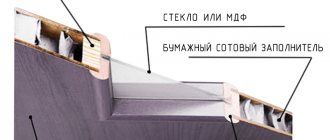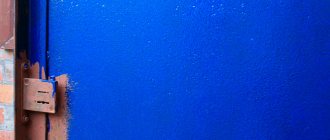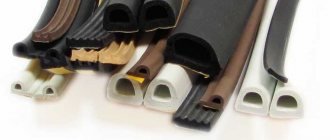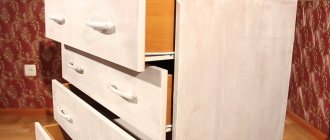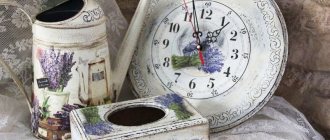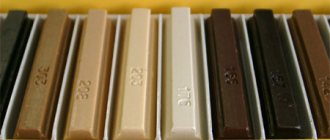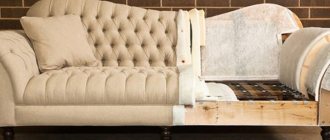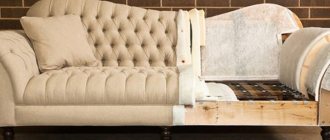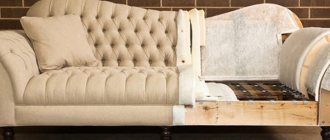With the passage of time, things often become unusable. This also applies to interior doors, which also deteriorate or have an unpresentable appearance. You can restore an old door leaf yourself in several ways. It is worth considering the type of material, degree of wear and financial capabilities. A door made of veneer can be easily confused with products made of natural wood, but the former are much lighter. Considering the manufacturing technology, restoration will not cause problems.
Painted doors
How to paint veneer doors. VENEER DOOR
An interior structure made of veneer is visually quite similar to a product made of natural wood, but their weight category differs significantly - the former are lighter in weight and also have greater functionality.
For a more detailed consideration, it is worth delving into the features of making veneered doors. Veneer is a very thin cut of valuable wood. Its purpose is based on decorative finishing of the surface of the door leaf and frame. This material is quite “capricious” and demanding, for example, in comparison with laminate. Veneer finishing gives the door textured lines and a natural shade of natural wood.
The most commonly used technique is to attach veneer to the panel structure. The method is as follows: blanks of edged or calibrated timber (preference is given to coniferous wood) are glued to an MDF (fibreboard) panel. The skeleton of such a modification is responsible for the intended geometry of the door structure, and also makes it more resistant to various negative influence factors (temperature, humidity). Using a special technological process (dynamic hot pressing method), the veneer coating is glued onto the MDF board.
Photo 2 Sequence of painting the door structure.
The sizing of the finish and base surface is carried out by heating the wood, from which the resin is released. This eliminates the need to use synthetic adhesive compounds. To ensure a glossy shine, the product is coated with several layers of varnish, with the required shade. The final color of the canvas depends on it. One batch of veneered doors, similar to those made from solid wood, has a significant difference in color, despite the fact that the manufacturer is the same.
The main reasons for this difference are considered to be the unique cut pattern of the wood and its light refractive index. The harmonization of the wood pattern is complicated by finishing with several sheets of veneer, which makes each of the models unique and original. Of course, you can choose designs that are similar in color, but the texture and pattern will vary.
In some cases, the internal structure of the canvas is filled with cardboard honeycombs, which significantly reduces its weight. Many people prefer this factor when choosing interior doors.
There are products covered with an artificial analogue of veneer - a special film. They have a 2D effect that imitates the pattern and texture of natural wood. It is quite difficult to visually distinguish such doors from a veneered structure. The advantage of such a door leaf is its increased moisture resistance.
Important nuances
Before you start painting any furniture at home, you need to carefully study the entire process of applying paint and varnish. We also recommend watching several videos that describe painting polished furniture, since this operation requires special skills and taking into account some of the nuances of the material.
The question of whether it is possible to paint polished furniture cannot be answered unequivocally. Painting this type of interior items requires careful preparation and experience in the restoration field. If you need to paint a large area of a polished surface, we recommend that you contact a professional, otherwise you may get a poor-quality result and spend a lot of time and effort.
It is worth taking care to protect the surface to be painted (usually fittings) if it will often come into contact with hot objects. For this, special fire-retardant solutions are used, for example, Polystyl or Neomid.
Painting doors. Varnish
This category of materials includes compositions that are often used to consolidate the result after painting with acrylic paint or stain. Varnishes are transparent and tinted. The former are ideal for emphasizing the natural texture of wood, the latter for adding a slight shade and shine.
Varnish is used not only for decorative purposes; it is necessary when the surface of a wooden product needs to be protected from external adverse factors.
There are several types of varnish:
- Alkyd. Just like paint from this group, it creates a durable coating that is resistant to temperature fluctuations and has water-repellent properties.
- Acrylic. The material is resistant to high humidity and does not deteriorate under the influence of ultraviolet rays. It has no pungent odor and comes in glossy or matte finishes.
- Nitrocellulose. Painting interior doors with this composition is possible only in dry rooms with an optimal microclimate, since the resulting coating does not have sufficient strength and can quickly crack.
- Polyurethane. It has good adhesion to wooden surfaces and is characterized by the strength and durability of the coating. Available in glossy, semi-gloss and matte. Not only doors, but also veneer, countertops and even parquet can be coated with this varnish.
- Polyester. It has high strength and wear resistance, but is toxic. It has a strong chemical odor, so it is best used to cover outdoor doors.
Further care
It is worth using interior doors carefully, keeping them clean, and avoiding mechanical damage. There is a list of products that do not need to be applied to this door leaf:
- hard abrasives;
- liquid cleaners containing active chemical components;
- iron scrapers.
With proper care, the door leaf will look beautiful for a long time.
How to paint dark doors light. Preparing for coloring
Before you start painting, remove the door from its hinges. In the event that you only need to slightly update the paint layer, this is not necessary. Painting doors in an apartment with your own hands begins with preparing the workplace. The door removed from its hinges is laid horizontally on suitable supports at a height of at least 50 cm from the floor. Ordinary stools are successfully used as supports, on which boards the width of the door leaf are placed. The supports must be covered with a non-slip, lint-free, dense fabric. The door is processed first on one side, then turned over to the other. The first stage of work is removing the layer of old paint. For convenience, all fittings (handles, hinges, etc.) are first removed, and a small amount of cotton wool or rags is placed in the holes. To remove a layer of old paint, use a solvent, a stiff wire brush or sandpaper.
After removing the paint, level the surface of the interior door, fill the cracks with putty, polish the surface with a grinding machine or fine-grained sandpaper and apply a layer of primer. The primer is prepared from the same paint that will later be used to paint the main background. To prepare it, the finished paint is diluted with a solvent in a ratio of 1:3. The resulting composition is used to prime the canvas in 1 layer. If necessary, after priming, it is putty again, partially or completely. All of the above applies to interior doors made of wood. When preparing to paint doors made from other materials, there are some important points to keep in mind:
- It is enough to remove the top layer of varnish from a veneer door. If you only need to slightly update the gloss, then the paint is applied over the previous coating;
- Only the top layer of waxy dirt-repellent impregnation is removed from the laminate canvas;
- doors made of MDF and chipboard are prepared for painting in the same way as wooden doors.
When the remnants of the old paint have been removed from the door and its surface is prepared for the application of new paint, begin painting. To paint a wooden door in an apartment, it is most convenient to use a roller, and to work on small details and protrusions, use a small brush. It is convenient to use a special spray gun to apply paint. This is especially true in the case of painting a door made of MDF. Before applying the paint, it is recommended to carefully filter it: this will make the coating more dense and uniform.
Important! The door leaf is painted only in one direction! You cannot put layers of paint towards each other. During work, avoid direct sunlight on the door leaf. The room must be protected from dust and midges, which, sticking to fresh paint, will ruin the job.
If you want to varnish the surface, be sure to wait until the paint layer has completely dried. This process takes a day for acrylic paints and two to three days for alkyd enamels.
Required tools and materials
Tools for painting veneered doors
To paint a veneered door with high quality, there is no need to purchase expensive equipment. In most cases, everything you need can be found in your home pantry.
To work you will need:
- rubber spatula;
- stationery knife;
- sandpaper;
- wash;
- brush;
- roller;
- spray gun or spray gun;
- square;
- primer;
- final paint coating.
The specifics of the upcoming activity should be taken into account. It must be performed in protective glasses, gloves, a respirator, and in conditions of high-quality ventilation of the room.
How to paint faux veneer doors. How and with what to paint a veneer door
First of all, you need to decide for yourself whether to paint the door completely or leave the color of the natural solid wood. The choice of restoration method depends on how damaged the veneer surface is. If there are few defects and they are represented by shallow scratches, you can get by with regular varnishing, and then thoroughly rub the surface with polish. Small scratches are quite easy to remove; all you need to do is use a varnish of the desired shade.
However, sometimes it happens that after purchasing a veneered door, it turns out that its color does not quite meet expectations, since it does not suit the interior of the room. What can be done in this case? If the canvas is completely new (it has not been used), it can be varnished in a different tone without removing the previous layer of varnish. Floor coverings do an excellent job with this task, but not furniture ones.
The old layer of varnish is removed with fine sandpaper or using a special varnish remover. In this case, a grinding machine cannot be used, since due to the high speed of operation, indentations will appear on the surface of the door and the thin veneer coating will be hopelessly damaged.
If the color of a veneered door needs to be changed radically (damage to the surface is very noticeable at first glance at a considerable distance), you need to prepare to perform some additional work. The algorithm of actions in this case consists of surface preparation and application of paint and varnish material. All work on the surface of natural veneer should be carried out with the utmost care - it is very easy to damage due to its microscopic thickness. If you do not have the necessary skills and experience, it is better to entrust such work to professionals.
The surface for painting is prepared by gradually stripping it of the previous layer of varnish and simultaneously removing dirt and dust. Next, you need to cover up all the unevenness with a layer of special primer. A door coated with veneer can be repainted with polyurethane, glypthal or water-based paint.
You cannot use nitro paint, as unsightly matte spots may appear on the surface of the veneer. The most suitable option for veneer is water-based paint. Before you start painting the door, you need to wait until the primer is completely dry.
Theoretically, you could also paint a faux veneer door. However, this is quite difficult to do in practice, since it is unlikely that you will be able to choose a paint that will not roll off the smooth surface of the film and will not damage it. And if the film is first coated with a layer of primer, this will destroy the effect of natural wood.
There is another way to make a truly high-quality restoration of an artificial veneer door. This is an important point that must be taken into account if you happen to buy just such a model along with an apartment.
We consider it necessary to remind you once again - before you start painting a veneer door, you need to decide how important it will be to completely change the appearance of the product, and what is better to use - paint or varnish. If you try to change the surface layer using chemical dyes, you can ruin the environmental friendliness of the door. A simple consultation with a competent veneer door specialist can solve many questions.
Design ideas
Using a stencil to paint doors
Classic remains a popular interior style, but an increasing number of people are turning to modern, high-tech and other new ways of decorating premises. Veneered door panels, for all their naturalness and attractiveness, do not fit into this design. By approaching this problem creatively, you can realize all your ideas and fantasies in accordance with your planned housing design project.
You can use one of the proven ideas for painting an interior door:
- Using a stencil. The procedure is long, delicate, requiring care and attention, but brings excellent results. Ready-made factory-made stencils or those developed independently are taken. Before applying the next material, you need to wait until the previous one is completely dry. The style of the drawing is selected in accordance with the design of the room and the priorities of the residents. It is better to paint with a spray gun, so as not to inadvertently pick up the inner edges of the slots with a brush.
- Several flowers. This approach is very effective when walls, floors or furniture are decorated in a similar style. The fabric elements and inserts are painted in different shades; various geometric shapes are applied to flat surfaces - stripes, rectangles, squares, rhombuses, ovals and circles. Experienced craftsmen recommend using two, maximum three shades so that the composition does not look colorful and tasteless.
- Artistic painting. An original option that fits well with similarly designed wallpaper or furniture. To create a picture or an original ornament, it is not necessary to have professional painting skills. You should use the proven technology of dividing the picture into cells and transferring it to the canvas, as if on a canvas. Another modern option is to use a projector. First, the contours are applied, and then the coloring is carried out directly.
- Textured surface. This technique is used when you need to preserve the surface texture of the canvas, but change its shade. To do this, you need to take a diluted solution of paint, which will create a thin layer that creates a new shade, but preserves the structure of the wood. Depending on the purpose, the surface is made matte or glossy.
With the right choice and well-executed technology, you can quickly and inexpensively restore an old door so that it fits seamlessly into any interior.
Preparing the door covering
Well, let's figure it out further, how to paint a door correctly? Preparatory work is carried out according to the following scheme:
- Remove all old coating, even primer and putty, until the wood itself remains. For this work, you can use a grinder, a hair dryer, or special cleaning compounds.
- Then you need to sand the surface, remove any defects, sand off small paint residues, and degrease. This work cannot be done without a sander, which is best connected to a vacuum cleaner. If you don’t have such a device, you can get by with medium-grain sandpaper.
Plastering a door
- When you have completely managed to sand the canvas and prime it, you can move on to puttying large flaws. If you plan to use varnish as a finishing coat, it is better to use a special composition for wood. If the decorative dye is not transparent, you don’t have to worry about the color of the putty. Don't forget about the gaps at the walls and baseboards!
- After puttying, after waiting the time specified by the manufacturer of the mixture, you need to sand again, masking the abrasions. You can immediately use a medium-grained cloth, and then finish with a fine-abrasive one.
If the doors under the old finishing materials have darkened, and you would like to simply open them with varnish, preserving the structure and pattern of the wood, problem areas can be lightened. To do this, you can prepare a simple bleach with your own hands: mix bleach with water in a ratio of 1:3. When the surface is completely processed, wiped with a rag and dried (so that the paint does not begin to swell), you can begin directly painting the door.
The process of painting lacquered furniture
Painting a varnished surface is easy. This process does not require any special material costs and will take you very little time. However, you should strictly adhere to the instructions and tips for finishing work outlined below. Let's look at how to paint polished furniture (let's take a cabinet as an example):
- A polished cabinet requires careful preparation (elimination of all drawers, components, various stands and doors). Next, the interior shelves, various recesses, as well as joints and corners are painted.
- Shelves, drawers and doors are painted separately from the main surface of the furniture (which must first be covered with a special film). If you are going to paint furniture yourself for the first time, then paint with a roller rather than a brush, so you can cover the desired area more evenly.
- After painting all the internal elements, we move on to painting the main surface. Apply the paint with slow, careful movements, avoiding smudges and omissions. After the first layer has dried, apply the coloring composition again - this will create the most uniform and durable coating.
- After the paint has completely dried, we begin assembling the structure. At this stage, you can decorate or sand the surface to give it a custom design.
To paint polished furniture, a spray bottle will come to your aid. Compared to a standard brush and roller, it distributes the paint more evenly without any overlap or streaking.
Repainting an old chest of drawers (2 videos)
Ecodecor: how to repaint old furniture with chalk paint (step-by-step instructions)
Receive one of the most read articles by email once a day. Join us on Facebook and VKontakte.
In pursuit of a modern and relevant interior, all old furniture, as a rule, goes to the trash. But there are solutions that will help turn old furniture into a modern eco-interior item. This material contains step-by-step instructions from a successful Belarusian artisan, which will clearly show how to breathe new life into old furniture.
You will need: - acrylic enamel, - dry fugue, - colors, - varnish, oil or wax (to choose from), - brush, - foam roller, - masking tape, - sandpaper, - screwdrivers, pliers, - wood glue, - clamps , - laundry soap, - soda ash, - ammonia, - gloves, mask.
For an example of restoration of any old furniture, this material uses an old bedside table.
DIY painting steps
Painting the door should be carried out according to an algorithm that includes several stages:
- Removing a layer of old varnish or previous coating by treating the door with a soap solution and a solvent used for paint. If necessary, you can use sandpaper (you can do without removing the base layer if the coated canvas is not damaged).
- Puttying with a special solution, which you can make yourself by mixing sawdust in PVA glue. After drying, you need to sand the surface with sandpaper.
- Painting begins with the panel, making even brush strokes along the fibers, after which the recesses and ends are treated.
- After the first painting of an interior door in an apartment, the coating will seem to be applied unevenly, so a second application of paint is used after sanding the first layer.
- Before painting the door frame, apply masking tape to the wallpaper adjacent to it to protect its surface.
It is better to carry out self-painting work with the canvas removed from the hinges. Before starting, you need to inspect it for any irregularities, which are repaired with a special primer.
In most cases, veneered doors have a certain pattern, so painting with a spray gun is quite complicated and should be done by professionals. The choice of paint is determined by the old coating and available financial resources. The best option is to use acrylic enamel, which gives a matte finish to the surfaces. But she's expensive. When using it, it should be taken into account that it must be secured with a reinforcing coating.
When painting doors made of artificial materials, it is better to turn to professionals, because due to paint running off the canvas, poor-quality painting may occur.
Actions in case of minor errors in operation
You can fix minor scratches or chips yourself. Select a transparent furniture varnish or wax furniture polish. If the area of damage is small, only this surface is painted over. If an area with chips or scratches is visible at a distance of 1 m, then you need to paint the entire canvas to eliminate shine.
Restoration of wooden surfaces
No matter how carefully you handle the furniture, abrasions, scratches, and stains still appear. They are easy to eliminate. The main thing is to know how and with what.
- If the wooden surface has simply lost its shine, find a wood care product that contains orange oil. Take a clean sponge, dampen it slightly and microwave for 20-30 seconds. Spray the product from a spray bottle, then wipe with a hot sponge (hands should be wearing rubber gloves with a coating on the inside).
A hot sponge and orange oil will restore the shine of wooden furniture
Such transformations are possible using a marker, alcohol and wax.
Gas mounting gun HILTI GX 120
Sano published an article in Tools and Equipment, March 11, 2012, article
But a tool is a tool, and knowledge of safety precautions and rules on how to work with it has not stopped anyone.
By the way, it would be useful to note that bringing a tool to the workplace like this, showing it in action, even in the hands of a representative, or even trying out the signature move of the Hilti company yourself, it’s very convenient to try everything yourself before purchasing and then decide whether the tool is suitable or what you need. something else.
What will you need for work?
Has the glossy surface lost its distinctive shine, dulled and lost its original appearance? Then you need to take care of painting the aged piece of furniture. To do this, you just need to apply a new coating. Let's start with what materials and tools you will need:
- acrylic based paint;
- glossy or matte varnish;
- roller and brush for applying paint;
- scraper and metal brush to remove the old layer of varnish;
- sandpaper (or sanding machine);
- primer solution (for repainting wood surfaces);
- solvent and detergent;
- protective composition for wood (antiseptic).
Peculiarities
Veneer is an inexpensive, environmentally friendly material, consisting of wooden sheets up to 1 centimeter thick. In the manufacture of furniture, doors and other structures, veneer sheets are glued to a strong and dense wooden base, which is usually used as chipboard and fiberboard (MDF). Veneer has the texture, visual appeal and properties of natural wood.
Its use makes it possible to produce inexpensive and lightweight structures (furniture, interior doors, flooring), which are visually almost indistinguishable from products made from solid wood.
At the same time, the thinness and fragility of the veneer plates cause its fragility and vulnerability to moisture and mechanical damage. Taking these features into account, primary and re-painting, as well as surface treatment of veneered products, is carried out with the utmost care. Careless and inaccurate actions when working with veneer can cause damage to the material, the appearance of cracks, deep scratches and chips on its surface.
Looseness is another characteristic feature of veneer that distinguishes it from solid wood. This feature causes increased consumption of paints and varnishes when working with veneered surfaces. This nuance should also be taken into account when planning to paint veneered structures at home.
Painting veneered products requires preliminary preparatory work. The features and stages of their implementation depend on the initial state of the structure, the type and thickness of the old paintwork, the nature and depth of existing damage.
Which paint to choose
First, decide what paints are used to apply to the door:
Alkyd enamels. This is the most affordable option. Film strength is average. The advantages include a large range of colors and compatibility with MDF, fiberboard and wood. The main disadvantage is the long drying time and the characteristic pungent odor. Among materials of this type there are a large number of glossy coatings.
- Acrylic enamels. This type of paint is a water dispersion of acrylates. The main advantage over other compositions is the absence of odor and quick drying. In addition, the color palette, represented by hundreds of colors, allows you to create unique shades yourself. To protect the surface, it is additionally coated with parquet transparent varnish.
- Oil-based tinting paints are great for transforming interior and entrance doors. Absorbing into the wood texture they give it a unique shade. The only condition for their use is wood, without any coating.
Variety of paints and varnishes
Nitroenamels. They dry quickly, but at the same time a volatile, caustic solvent evaporates, which can cause ill health and even poisoning
If you take precautions and use personal protective equipment when working, then this option deserves attention. After complete evaporation of the solvent, the coating becomes safe
It is considered a high-quality and fast method of painting. Colored varnishes, glazes. These materials are used for painting varnished door panels. Used in cases where there are no significant cracks or chips on the base. To fully restore the varnished surface, the old varnish must be removed, or you can refuse to re-varnish and paint over the interior doors after puttying.
Kitchen 2022: 5 key trends
We tell you what kitchen design to choose today so that it is relevant tomorrow
Sand the surface
Your product should be completely covered with small scratches. To do this, use fine sandpaper, but if one of your friends has a sanding machine, it’s time to remind these friends about yourself.
Prepare for painting
To do this, you need to remove dust and degrease the surface: wipe it with a damp cloth, and then with a cloth with degreaser or alcohol. The remaining glue from the film will also have to be sanded off and degreased. After this, you need to putty the products: remove all holes from old handles, shelves and fasteners, cracks and irregularities. After this, sand and degrease the surface again.
Apply primer
To ensure that the paint adheres to the surface, cover the surface with primer. Choose an unscented primer, such as Otex Akva from Tikkurila, it doesn't smell! Liquid, water-based, dries quickly. Prime in two layers, allowing each layer to dry.
